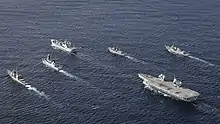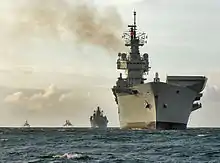UK Carrier Strike Group
The UK Carrier Strike Group (UKCSG) is a carrier battle group of the British Royal Navy. It has existed in various forms since the mid-2000s.[1][2] Between 2006 and 2011, the formation centered around the Royal Navy's Invincible-class aircraft carriers until the retirement of their Harrier GR9 strike aircraft in 2011 as a result of the Strategic Defence and Security Review. The UKCSG subsequently returned in February 2015 ahead of the entry into service of the new Queen Elizabeth-class aircraft carriers, HMS Queen Elizabeth (R08) and HMS Prince of Wales (R09).[2] The aim of the CSG is to facilitate carrier-enabled power projection.[3]
| UK Carrier Strike Group | |
|---|---|
 HMS Queen Elizabeth and her carrier strike group during Exercise Westlant 19. | |
| Active | 2006 – 2011 2015 – present |
| Country | |
| Branch | |
| Type | Carrier strike group |
| Commanders | |
| Current commander | Commodore Steve Moorhouse Commander United Kingdom Carrier Strike Group |
| Aircraft flown | |
| Attack | Wildcat HMA2 |
| Fighter | F-35B Lightning II |
| Attack helicopter | Apache AH1, Wildcat AH1 |
| Patrol | Merlin HM2, Wildcat HMA2, Merlin HM2 Crowsnest |
| Transport | Merlin Mk3i/4, Chinook HC4/5/6/6A |
History
2006–2011

The earliest iteration of the UK Carrier Strike Group originally formed in 2006 with Commodore Alan Richards in command.[2] It centered around either of two Invincible-class aircraft carriers, HMS Illustrious and HMS Ark Royal.[2][4] In one of its final deployments, it demonstrated its capabilities alongside the U.S. Navy off the east coast of the United States during Exercise Auriga in 2010. Following the exercise, the captain of Ark Royal remarked: "Today was a great opportunity for us to demonstrate some of the capabilities that the UK Carrier Strike Group has, particularly the GR9 Harrier and Merlin ASW helicopters operating from HMS Ark Royal".[5][4] As an example of the size and composition of a UK CSG of that era, the Auriga CSG consisted of the aircraft carrier HMS Ark Royal, along with her air wing of Harrier GR9 strike aircraft, Merlin HM1 anti-submarine warfare (ASW) helicopters and Sea King MK7 airborne surveillance and control (ASaC) helicopters.[6] The aircraft carrier was escorted by the Type 42 destroyer HMS Liverpool and Type 23 frigate HMS Sutherland, in addition to French Navy submarine Perle and U.S. Navy destroyer USS Barry. RFA Fort George of the Royal Fleet Auxiliary provided replenishment.[7]
In 2010, the British government announced that all Harriers would be retired from service, along with HMS Ark Royal. This left Illustrious serving in a helicopter carrier role whilst replacement aircraft carriers and their associated air wings were procured. The UK Carrier Strike Group dissolved in 2011 with Commodore Simon J. Ancona as its final commander.[2] Illustrious later went on to decommission in 2014, three years ahead of her replacement.[8]
2015–present
In 2015, the UKCSG was re-formed with Commodore Jerry Kyd as its commander. Under the direction of Kyd, the UK CSG Battle Staff grew to include 22 core One-Star Battle Staff by 2016.[9] Kyd was later succeeded by Commodore Andrew Betton during the same year, who himself was succeeded in 2018 by Commodore Mike Utley, before the current commander, Commodore Stephan Moorhouse, took command in 2019.[2] Prior to the entry into service of HMS Queen Elizabeth and her sister ship Prince of Wales, the Royal Navy cooperated with its allies to preserve and develop its skills in carrier strike group operations. This primarily involved Royal Navy ships and personnel training with U.S. Navy and French carrier strike groups.[10][11]
The current UKCSG assembled at sea for the first time in October 2020 during Exercise Joint Warrior.[12] It comprised a total of nine ships, 15 fighter aircraft, 11 helicopters and 3,000 personnel. The Royal Navy ships included the aircraft carrier HMS Queen Elizabeth along with two frigates, two destroyers, a replenishment ship and a solid support ship. The U.S. Navy and Royal Netherlands Navy also provided an escort each.[12] The exercise saw the largest number of aircraft on a British aircraft carrier since 1983, in addition to the largest number of F-35B’s at sea across the globe.[13]
The exercise was a rehearsal for an operational deployment scheduled for 2021, known as CSG21.[14]
CGS21 will demonstrate a fully sovereign UK carrier strike group comprising:[14]
- HMS Queen Elizabeth (R08)
- HMS Diamond (D34)
- HMS Defender (D36)
- HMS Kent (F78)
- HMS Richmond (F239)
- An attack submarine of either the Trafalgar or Astute class.
- RFA Fort Victoria (A387)
- A Tide-class tanker

Following Exercise Joint Warrior, the UK CSG reached its initial operating capability (IOC) milestone in January 2021. This milestone marked the successful operation of all components of the CGS and made it available for operational deployments for the first time.[13]
The size and composition of the UKCSG varies depending on operational requirements which are decided upon during operational planning.[3] It typically consists of a Queen Elizabeth-class aircraft carrier, two surface escorts (with one being a Type 23 frigate for anti-submarine warfare and the other being a Type 45 destroyer for anti-air warfare), a submarine and a fleet tanker.[15] In the future, escort duties will also be provided by the Royal Navy's new Type 26 frigate.[16] For replenishment-at-sea, the Royal Fleet Auxiliary provides its Tide-class fleet tankers, which were specifically designed to refuel the aircraft carriers, in addition to RFA Fort Victoria for dry stores.[17] Currently, Fort Victoria is the only ship capable of resupplying the aircraft carriers with dry stores, however a programme to replace her with three new solid support ships is currently underway.[18] Additionally, escorts and support ships may be provided by allies.[19] A number of overseas naval facilities have been established to support the UKCSG, including the naval base HMS Jufair and the UK Joint Logistics Support Base, which are located in Bahrain and Oman, respectively.[19]
The Queen Elizabeth-class aircraft carriers are designed to carry around 40 aircraft but can carry up to 72 at maximum capacity.[20] Its carrier air wing (CVW) will consist of up to 24 F-35B Lightning II multirole fighters by 2023.[21] This is in addition to around 14 helicopters of varying types.[22] For a Maritime Force Protection tasking, the CVW may consist of nine Merlin HM2 anti-submarine warfare helicopters and five Merlin HM2 Crowsnest for airborne early warning (AEW). Alternatively, for a Littoral Manoeuvre package, it may consist of a mixture of Chinook and Merlin Mk3i/4 transport helicopters and Apache AH1 and Wildcat AH1 attack helicopters.[21]
References
- Navy News (PDF) (October 2015 ed.). Royal Navy. p. 14.
- Royal Navy Senior Appointments, 1865- (PDF). Royal Navy. Retrieved 5 November 2020.
- "Fleet Solid Support Ships: Procurement". Hansard. Retrieved 5 November 2020.
- "Navy Command senior staff CSV". Ministry of Defence. Retrieved 5 November 2020.
- "IN PICTURES: Royal Navy's Amphibious Task Group heads for USA". Ministry of Defence. 17 June 2010. Retrieved 5 November 2020.
- A Global Force: 2010/11 (PDF). Royal Navy. Retrieved 6 November 2020.
- "Royal Navy's HMS Ark Royal to lead global exercises". BBC News. 6 April 2010. Retrieved 6 November 2020.
- "HMS Illustrious takes final bow". Ministry of Defence. 28 August 2014. Retrieved 5 November 2020.
- "New Commander UK Carrier Strike Group". Royal Navy. 15 September 2016. Retrieved 9 November 2020.
- "Royal Navy Carrier Strike Group Put to the Test". Royal Navy. 19 January 2017. Retrieved 9 November 2020.
- "Military Cooperation United Kingdom and France" (PDF). Ministry of Defence. Retrieved 9 November 2020.
- "UK Carrier Strike Group Assembles for the First Time". Royal Navy. 5 October 2020. Retrieved 5 November 2020.
- "Carrier Strike Group hits important milestone". Ministry of Defence. 4 January 2020. Retrieved 4 January 2020.
- "Counting down to the UK Carrier Strike Group 2021 deployment". Save The Royal Navy. 7 July 2020. Retrieved 5 November 2020.
- "Britsh Navy Queen Elizabeth aircrat carrier with its Carrier Strike Group deployed in the North Sea". Navy Recognition. 5 October 2020. Retrieved 5 November 2020.
- "What Are The Type 26 Frigates?". BFBS. 21 October 2019. Retrieved 6 November 2020.
- "New ship to support the aircraft carriers arrives in UK". Ministry of Defence. 25 September 2017. Retrieved 5 November 2020.
- Allison, Geoge (21 October 2020). "Government confirm new Fleet Solid Support Ships will be built in UK". UK Defence Journal. Retrieved 5 November 2020.
- "Carrier strike strategy and its contribution to UK defence". Parliament. 25 February 2019. Retrieved 5 November 2020.
- "HMS Queen Elizabeth: All You Need To Know About Britain's Aircraft Carrier". BFBS. 15 October 2020. Retrieved 6 November 2020.
- Allison, George (9 February 2018). "What kind of aircraft and how many of them will HMS Queen Elizabeth carry?". UK Defence Journal. Retrieved 6 November 2020.
- Allison, Geoge (21 October 2016). "How do the new British carriers stack up against the Admiral Kuznetsov?". UK Defence Journal. Retrieved 6 November 2020.